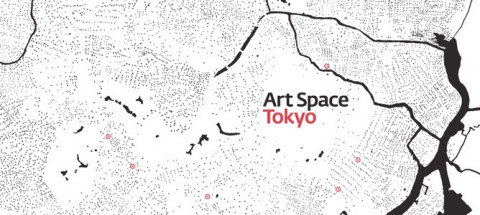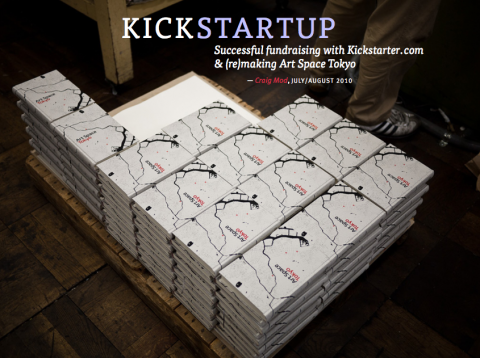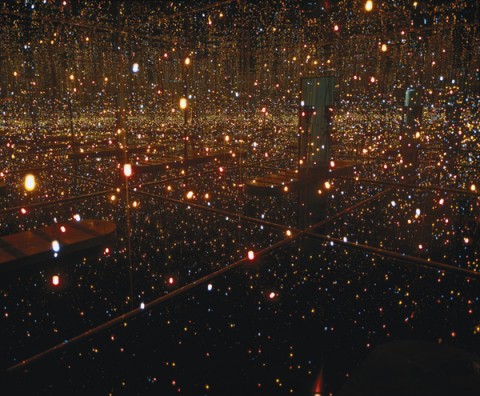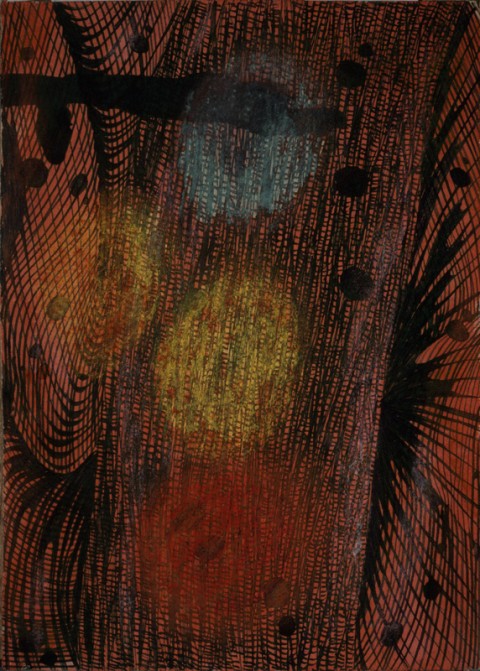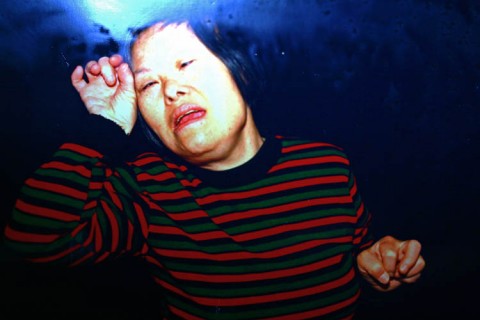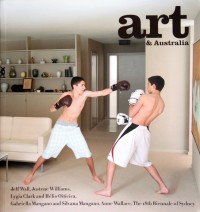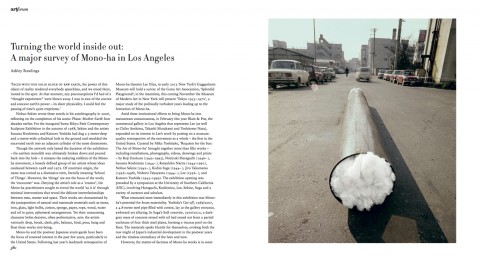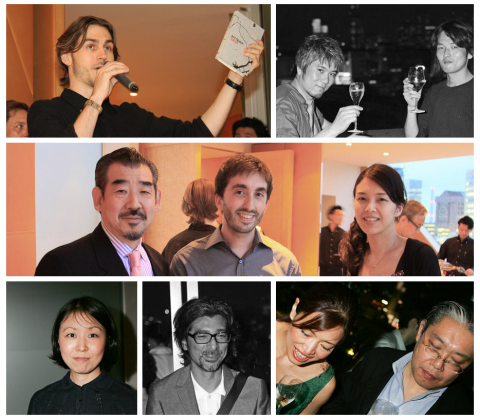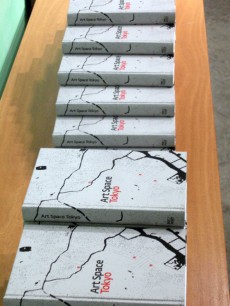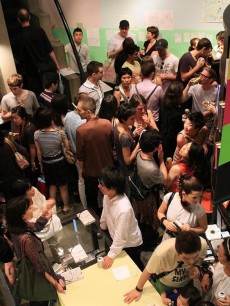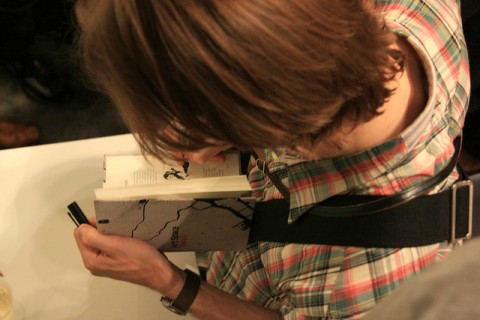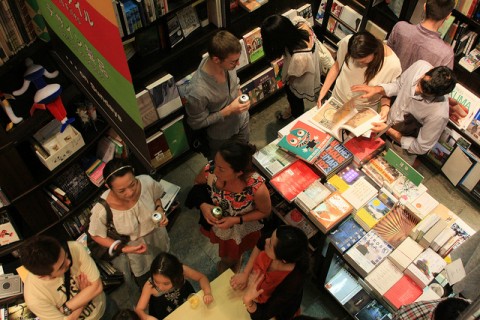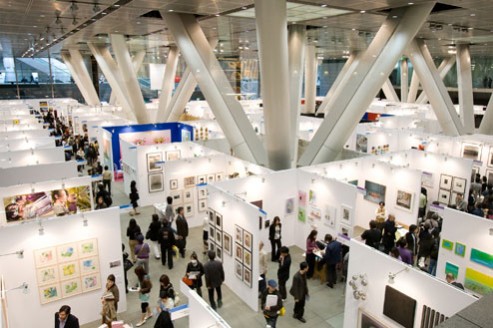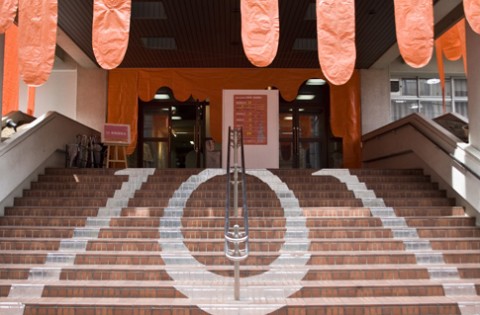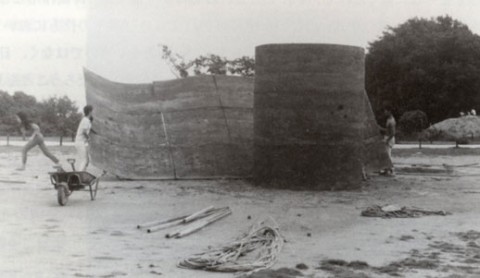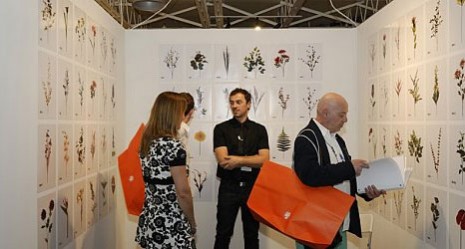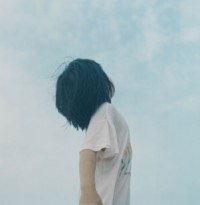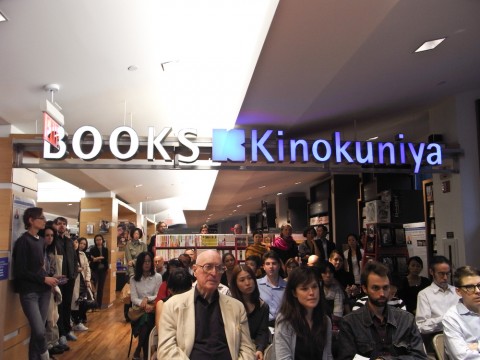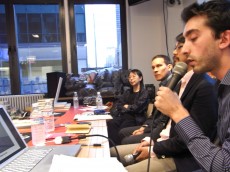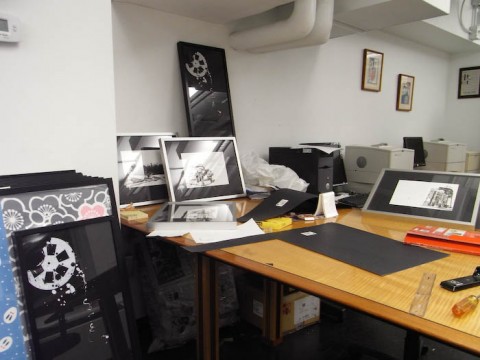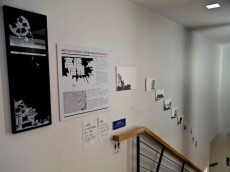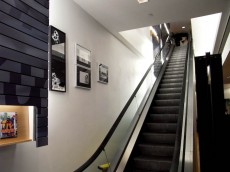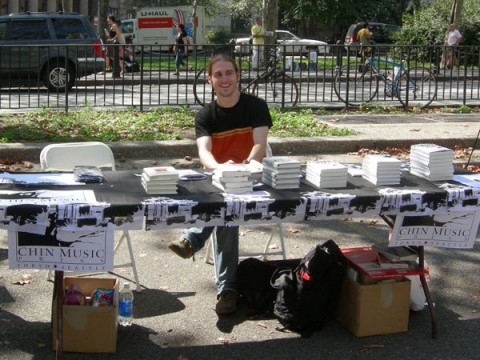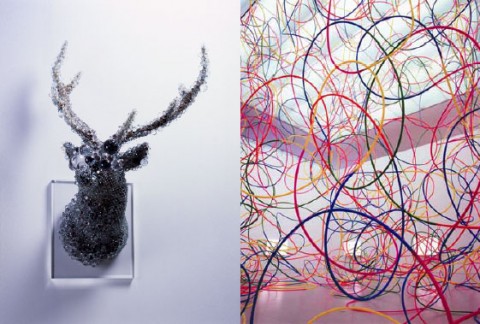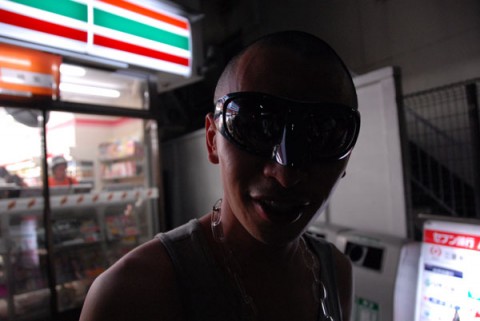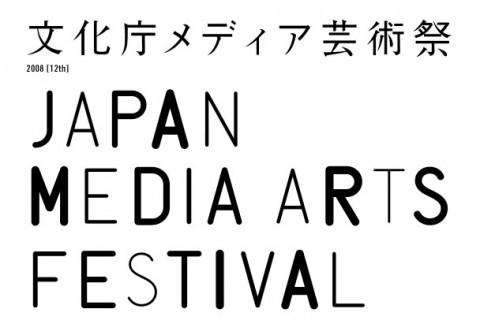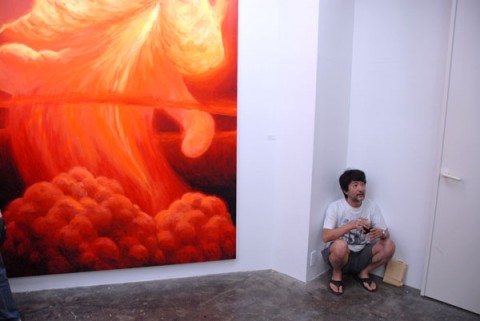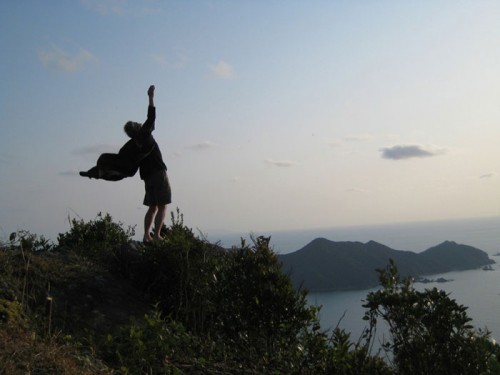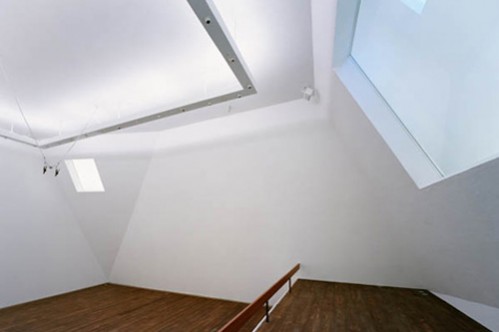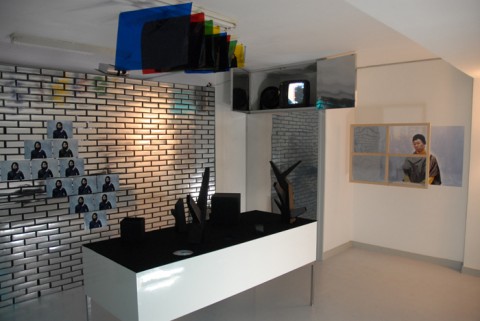Exhibitions & Events
Sayonara to the Art Space Tokyo Blog
After four years of running the Art Space Tokyo blog, it’s time to bring it to a quiet conclusion.
Activity on this blog has ebbed and flowed over the years. At the beginning we regularly posted reports and reviews, but after a year or two we became busier and busier. From 2009 onward, I usually only had time to post monthly round-ups of links to other people’s articles on Japanese art. Even though I only did them once a month, they were a completely tedious chore, but I was driven by hope that in the long term they would be a valuable resource: a centralized point of reference for what people were writing about Japanese art in the early 21st century. But nowadays I want to focus on other projects and not become bound to something merely for the sake of doing it.
Art Space Tokyo has been one of the most rewarding projects Craig and I have ever worked on. From mid to late 2007, we trekked the city in search of its most unusual galleries and museums and we came to know some of the curious characters who keep the Tokyo art world ticking along. In early 2008, we bound their stories into a book that we envisaged as a work of art in its own right, and we were unbelievably lucky to have it illustrated by one of our favorite artists—the gifted and prolific Nobumasa Takahashi.
Though the book bucked the trend of how the Tokyo art world prefers to present itself (something I wrote about in this essay), the reaction was overwhelmingly positive from the outset. We have met so many people for whom the book has been an invaluable gateway to the Tokyo art world, which can be so hard to figure out when you don’t know where to look.
We were stunned when the first (albeit small) print run was sold out within a year of publication. Without any great expectations, in May 2010 we launched a Kickstarter campaign to raise $15,000 for a reprint and the development of a digital version. Back then, Kickstarter was a completely new model of fundraising, so you can imagine our disbelief as we watched a torrent of contributions push us well past our goal and bring in $24,000. Again, to our backers: thank you, thank you, thank you. We will never forget the buzz at the relaunch party we held at the Watari Museum of Contemporary Art nor the rare spectacle of almost every major figure in the Tokyo art world gathered in one room at TODs Omotesando.
Our experience with Kickstarter prompted Craig to write Kickstartup, the first thorough examination of what makes a successful Kickstarter campaign. These days, you have to pull in a few-million-dollars’ worth of microfunding to catch anyone’s attention, but if you haven’t read Craig’s essay already, it’s worth it to remember what the climate was like back then—only two and a half years ago. From then on, Craig wrote more and more about the state of digital publishing. Books in the Age of the iPad (2010), Post-Artifact Books and Publishing (2011) and Subcompact Publishing (2012) are all essential reading. In only four years, the landscape of digital publishing has shifted so much, and I continue to be humbled by the clarity and reason that Craig brings to a still-nascent and contentious discourse.
Although it took us longer to bring it to you than we originally hoped, in the fall of 2012 we finally launched the promised digital versions of Art Space Tokyo. In keeping with the principle of “pointability” that Craig explains in his accompanying essay Platforming Books, the entire contents of Art Space Tokyo are available on read.artspacetokyo.com. Furthermore, this website offers a greatly expanded timeline of events in the Japanese art world since 1945, as well as extensive appendices of resources on the Japanese art world. Even if it’s only on an occasional basis, I will continue to update the timeline and appendices, and use @ArtSpaceTokyo as a simple way of drawing attention to things that are happening in the world of Japanese modern and contemporary art.
Looking back at the Japanese art world in the past four years, what has changed? In terms of Art Space Tokyo’s function as a guidebook, it is inevitable that its contents will gradually go out of date. Already, Nakaochiai Gallery shut its doors, Project Space Kandada closed and was reborn as 3331 Arts Chiyoda, 101Tokyo Contemporary Art Fair didn’t return after its second year, and Shinwa Art Auction no longer holds significant contemporary art sales in Japan. But I’m reassured by the thought that even if none of the institutions or individuals in Art Space Tokyo are active in 30 years from now, the book’s interviews and essays retain an enduring value as a historical record of the Japanese art world at the end of the 2000s.
In terms of the Japanese art world in general, it is hard to say what changes have taken place in the past four years. In the preface to the second edition I wrote, “…the recession, which caused hundreds of galleries to shut down in other countries, has not affected Tokyo’s art world to the same extent. There was no bubble in the Japanese art market in 2008, so nothing really burst.” While that remains true, now that more time has passed I do detect a more fundamental change than I had previously noticed. In the years before I left Tokyo for New York at the end of 2008, I remember there being a distinct sense of optimism that contemporary Japanese art might just be on the cusp of renewed recognition and that the tepid Japanese art market could only get stronger. However, having returned to Tokyo six months ago, there seems to be an underlying feeling of tired resignation to the status quo. It is understandable: after more than two decades of economic stagnation, the latest global recession is painfully familiar to the Japanese. Moreover, the catastrophic earthquake, tsunami, and nuclear contamination that ensued have all raised serious questions about the government’s competence and honesty, instilling genuine feelings of fear about this country’s future. It is still too early to say how the current climate is affecting Japanese artists, but it isn’t hard to imagine that in the coming years their work might become more cynical.
On a more positive note, there has been a global surge of interest in postwar Japanese art, particularly in the United States. In the past two years, there has been a slew of major museum exhibitions: most notably Tokyo 1955–1970: A New Avant-Garde at the Museum of Modern Art, New York; and Gutai: Splendid Playground at the Guggenheim, New York, opening on February 14. Commercial galleries have also been crucial to this renewed momentum. In New York, Hauser & Wirth recently held A Visual Essay on Gutai and for several years McCaffrey Fine Art has been putting on solid solo exhibitions of Hitoshi Nomura, Kazuo Shiraga, Sadamasa Motonaga, Jiro Takamatsu, and Noriyuki Haraguchi. In Los Angeles, Blum & Poe’s survey Requiem for the Sun: The Art of Mono-ha last February was instrumental to putting Mono-ha back on the map, and later in the year it was followed by a solo exhibition of Kishio Suga. Susumu Koshimizu’s solo show will start on February 23.
Though this activity is mostly taking place in New York and LA, there have been some crucial shows in Japan: a retrospective of Atsuko Tanaka at the Museum of Contemporary Art, Tokyo; Gutai: The Spirit of an Era at the National Art Center, Tokyo; 1968–1982: The 70s in Japan at the Museum of Modern Art, Saitama; and Jikken Kobo – Experimental Workshop at the Museum of Modern Art, Kamakura.
Frankly, the timing of all these developments is an incredible blessing for me, as my original field of specialization was postwar Japanese art, with particular emphasis on Mono-ha. I’m now working for Blum & Poe as the director of their forthcoming Tokyo space, details of which will be made public in the coming months. In the meantime, there is a huge amount of archival work that has to be done for the Mono-ha artists. This is what I am focused on these days. Likewise, Craig is cooking up all kinds of new things.
So, with a lot of nostalgia about the creation of Art Space Tokyo and pride about its life in the wild, Craig and I want to say once more how thankful we are to all our readers and supporters. We wish you a very happy 2013 and hope you make amazing books!
If you want to keep up with what Craig and I get up to, it’s all at craigmod.com and ashley.rawlings.com.
Mind the Mirror – Reflections on Yayoi Kusama
In the past few years Yayoi Kusama has achieved a stratospheric rise in global recognition, with solo exhibitions at the Hayward Gallery in London, 2010; Ota Fine Arts in Tokyo, 2010; Gagosian Gallery in New York, 2010, and Rome, 2011; Victoria Miro in London, 2010 and 2011; the National Museum of Art, Osaka, in 2011; the Museo Nacional Centro de Arte Reina Sofía in Madrid, 2011; the Queensland Art Gallery in Brisbane, 2011; and the Tate Modern in London earlier this year. That show is now at the Whitney in New York, where one of the main draws is Fireflies on the Water (2002), a dark room with a shallow pool of water and mirrored walls, filled with dozens of hanging fiber optic threads that glow gently in different colors. This cosmos-like installation is one of Kusama’s most intimate and moving works.
Looking back, one could argue that the renewal of her career began with her solo exhibition at the Serpentine Gallery in London in January 2000. It was my first encounter with her work and I loved that show so much I went back three times. It centered on Dots Obsession, a yellow room that was covered in black polka dots, as were the large, suggestively shaped balloons that bobbed around. In the next room, Kusama’s phallic “proliferation” sculptures created a palpable air of psychosexual anxiety. For a nineteen year old who was only just becoming familiar with contemporary Japanese art, Kusama’s obsessive, hallucinogenic worldview felt radically different and alluring. I admire artists who are adept at drawing you into their world, regardless of whether you actually like or identify with what they see. Though in principle the medium shouldn’t matter, immersive installations are often the most direct and compelling way to achieve that kind of blanketing intensity.
But the majority of such all-encompassing installations are tainted with some trace of the outside world. Standing in the corner of the Serpentine installation, I remember looking at the red emergency Exit sign hanging from the ceiling, half hidden by the balloons, and thinking that it was an unfortunate intrusion into the artwork, but that the exhibition organizers had clearly done their best to minimize its impact.
 It was curious, then, to visit Kusama’s solo exhibition at the Mori Art Museum in 2004 and experience her installations there. They were so badly compromised by didactic institutional interference that the Serpentine’s little red Exit sign seem artful by comparison. On display was a similar balloon room—red with white polka dots—which had a mirrored wall designed to create an aura of infinity. Yet, affixed to that mirrored wall was a sign warning you not to walk into it. And what remaining suspension of disbelief in the artwork one might have maintained was obliterated by the cleaners who were obsessively sweeping the floor on both the days I visited.
It was curious, then, to visit Kusama’s solo exhibition at the Mori Art Museum in 2004 and experience her installations there. They were so badly compromised by didactic institutional interference that the Serpentine’s little red Exit sign seem artful by comparison. On display was a similar balloon room—red with white polka dots—which had a mirrored wall designed to create an aura of infinity. Yet, affixed to that mirrored wall was a sign warning you not to walk into it. And what remaining suspension of disbelief in the artwork one might have maintained was obliterated by the cleaners who were obsessively sweeping the floor on both the days I visited.
The idea of using mirrors to achieve a sense of limitlessness was better employed in the next piece, You Who Are Getting Obliterated in the Dancing Swarm of Fireflies (2004), which was essentially the same as the version of Fireflies on the Water currently on show at the Whitney but without the pool of water. But again, preoccupations with health and safety regulations trivialized the whole experience. There was security guard was on hand to warn you about the shallow ramp that led you up into the room, and once in there barely a minute would go by without an attendant shining a flashlight toward the exit—just to be on the safe side, you know? The exhibition really jumped the shark a couple of rooms later, where one of the galleries had been filled with hay. “Visitors with olfactory sensitivities should be aware that the following room contains hay,” read the sign at the door. You know there’s a problem when the exhibition display is more obsessive-compulsive than Kusama’s own artwork.
For all the admiration I had for Kusama, the rampant commodification of her work has inevitably detracted from its quality and emotional impact. I have nothing against spin-off merchandise as a subsidiary or derivative element of an artist’s practice—and I’m respectful of artists who clearly use it as a tool of critique in its own right—but the ubiquitous, all-too-easily identifiable motif of Kusama’s polka dots have ended up eclipsing all that is actually interesting and historically significant about her earlier work. The radical, rebellious, messy flower-power aesthetics of the 1960s has been sanitized into poorly made keychains and other paraphernalia for the regular consumer and luxury clothes for the wealthy. Kusama was included in Akasaka Art Flower in 2008, for which artists’ works were installed in various locations in this high-end commercial and residential district of Tokyo. Her Dots Obsession (Day) and Dots Obsession (Night) installations were so badly executed—limp, wrinkled balloons and mounds that weren’t flush with the floor—that it seemed like the artist had simply phoned them in. It was so disappointing that I dedicated a paragraph to ranting about it in the 2008 end-of-year review I wrote for Tokyo Art Beat.
Kusama’s exhibition at the Whitney does a lot to redress this imbalance of spectacle versus artistic integrity. There are no polka-dot balloon installations. Rather, the museum goes out of its way to show the public what it rarely has the chance to see: early works in which you can see the germination of Kusama’s obsessions—dark, absorbing paintings of suns and prickly cell-like organisms. It’s astonishing to think that she was painting these things in the 1950s. These, and the many newspaper and magazine articles from the 1960s that are laid out in display cases are the most compelling aspects of the exhibition. The era in which Kusama asserted herself on the New York art scene comes to life.
I’ve been lucky enough to see beautifully executed versions of Fireflies on the Water twice―once at Gagosian in New York and once at the Louisiana Museum of Art in Denmark―so I didn’t feel too bad about not having time to preorder a timed ticket for the installation at the Whitney. While the rest of the show is open to general admission, visitors are only being allowed into Fireflies on the Water one at a time. You’ll only be allowed one minute in there, but from experience I can tell you that it is absolutely worth it.
Lieko Shiga’s Solo Exhibition at the Sendai Mediatheque
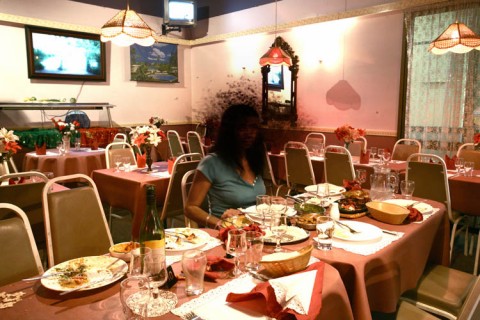
Just the other day, I was talking with Lieko Shiga on Skype about how to translate the titles of her new photographs and her upcoming exhibition at the Sendai Mediatheque in November.
Lieko is an old friend of mine who I met while at London’s Chelsea College of Art and Design in 2000. It has been amazing to see the growing recognition her work has received since then, particularly in the past five years.
She had been producing consistently good work throughout her time in London and Berlin, but it was after doing residencies in Sendai and Brisbane in 2006 that it gained real momentum.
In 2008, she won the 33rd Ihei Kimura photography award for her photobooks Lilly and Canary, and she has been included in numerous important group shows since—among them Trace Elements at Performance Space in Sydney and Tokyo Opera City Art Gallery (2008–09), On Your Body at the Tokyo Metropolitan Photography Museum (2008), Roppongi Crossing: Can There Be Art? at the Mori Art Museum, Tokyo (2010), and Double Vision: Contemporary Art from Japan at the Moscow Museum of Modern Art (2012).
Following her shows in 2008, I interviewed her for Tokyo Art Beat. A few months ago, the organizers of Krakow Photomonth, an annual photography festival in Poland, told me that Lieko’s work would be included in their program and asked me if they could reprint this interview in their tenth anniversary catalogue. The book does a great job of presenting her work.
The Sendai Mediatheque exhibition will be her first solo show at a major institution. The location is fitting, as Lieko has been based in the Tohoku region for the past five years. When the earthquake and tsunami struck in March 2011, it wiped out the coastal village of Kitakama that she was living in. She was lucky to survive. Aveek Sen wrote a very poignant essay about this period in her life for ART iT magazine.
I’ve had a preview of her new photographs, and they’re darker and more psychologically disorienting than ever. I can’t wait to make my way to Sendai in November.
Chiharu Shiota at Haunch of Venison, New York
Vernissage TV has done a short video on Chiharu Shiota’s solo exhibition at Haunch of Venison in New York. The show is centered around a towering installation of found window frames from East Berlin, as well as some of the artist’s small box-like sculptures in which personal found objects are tangled up in webs of black thread.
Article on “Requiem for the Sun: The Art of Mono-ha” in Art & Australia
Back in February, I went to Los Angeles to see Requiem for the Sun: The Art of Mono-ha,” a landmark exhibition of the late-1960s conceptual movement held at Blum & Poe.
The gallery is well-known for having represented Takashi Murakami and Yoshitomo Nara since the 1990s, but in recent years they signed on Lee Ufan, the Mono-ha group’s Korean-Japanese theoretician. Thus, it was a natural progression for Blum & Poe to hold a survey of Mono-ha as a whole—something that has never been attempted in the United States.
“Requiem for the Sun” was, quite frankly, astonishing. Anyone who has studied the movement will mostly have seen only photographic documentation of ephemeral works that have long vanished since their original presentation in the 1960s and ‘70s. Mono-ha is all about the “encounter” with raw materiality, so this exhibition was an invaluable opportunity for viewers to have that essential first-hand experience. The brute presence of installations such as Kishio Suga’s Soft concrete (1970/2012) spoke for itself.
The current issue of the quarterly journal Art & Australia features an article I wrote on “Requiem for the Sun.” In it, I frame the exhibition in terms of a recent surge of international interest in Mono-ha and the postwar Japanese avant-garde. Given that the artists do not “create” their works so much as “present” them, I ask how did the latest “re-presentations” at Blum & Poe compare with past iterations.
Particularly exciting for me was the re-presentation of Nobuo Sekine’s Phase – Mother Earth. Originally made in Kobe in 1968, this piece—a 2.7-meter-deep by 2.2-meter-wide cylindrical hole in the ground with an adjacent monolith of the same proportions—has only been re-presented four times since. The last time was in Tokyo in October 2008, a three-day process that I documented for Tokyo Art Beat. It was intriguing to see Phase – Mother Earth in Blum & Poe’s back yard, surrounded by palm trees. The piece is inherently characterized by the soil from which it is made, so the great majority of us have only seen its dark, earthen character in photos from 1968. In LA, the earth was much grittier and grayer—it felt inherently more “urban.”
You can read reviews of “Requiem for the Sun” on Artforum, Artnet, and the LA Times.
ART iT’s deputy editor Andrew Maerkle has also published Between Potentiality and Fatality, a three-part in-depth interview with Kishio Suga.
Art Space Tokyo’s July Party at the TODs Flagship Store
Following our party at the Watari Museum of Contemporary Art, we celebrated the relaunch of Art Space Tokyo in style at TODs.
The party was full of people featured in AST, but given the book’s focus on a specific set of venues, it was fantastic to see so many artists, gallerists, curators, collectors and editors from the broader Tokyo art scene in attendance.
You can check out the full photo report on the Pre-Post website.
AST’s July Party at the On Sundays Bookstore in the Watari Museum of Contemporary Art
On July 3, Craig and I held the first of two events to celebrate the printing of the second edition of Art Space Tokyo.
Kisato Kusano, the owner of the renowned On Sundays bookstore in the basement of the Watari Museum of Contemporary Art (one of the 12 spaces featured in the book) generously offered us the chance to use the space so we could bring in a big bad crowd of book lovers for an evening of free beer, wine and sake.
Thank you to everyone who came! It was great to see you out in force!
Photos by Xin Tahara and Ashley Rawlings.


Left: The stunning exterior of the Watari Museum.
Right: Kusano-san laying out copies of Art Space Tokyo.
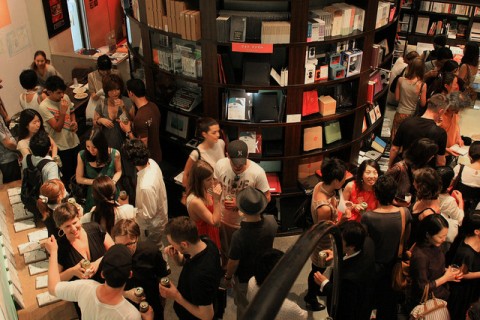
The On Sundays bookstore quickly filled up with supporters.

AST editor Ashley Rawlings talking to Megumi Matsubara from the Tokyo-based architectural office “Assistant.”

Kisato Kusano, the owner of On Sundays book store.
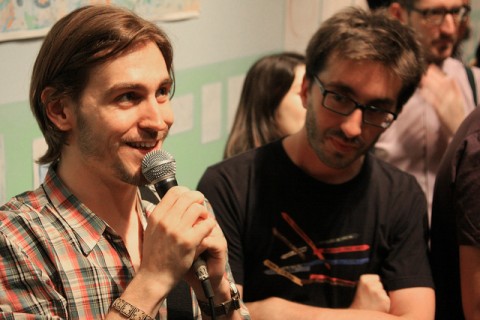
AST co-author, designer and publisher Craig Mod gives a speech about the Kickstarter fundraising that made this second edition a reality.

Naoki Matsuyama and Lena Oishi, who helped with the translation of Art Space Tokyo.
Setouchi International Art Festival – Call For Submissions
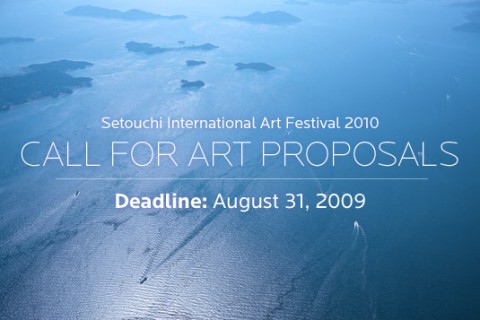
Since the early 1990s, a cluster of islands in the Seto Inland Sea have been developing into one of Japan’s major sites of contemporary art. Naoshima was the first, starting with its world-class, iconic museums Bennesse House and Chichu Art Museum, both designed by Tadao Ando.
The Art House Project has renovated old houses into site-specific installations by renowned artists including Rei Naito, James Turrell, Tatsuo Miyajima and Hiroshi Sugimoto. In recent years, nearby islands of Inushima and Teshima have become homes to a variety of art installations.
In 2010, the region will host the inaugural Seto International Art Festival, taking place from July 19 to October 31. The festival’s organizers are currently calling submissions, open until August 31.
Details are available on their homepage.
Art Fair Tokyo announces its 2009 line up.
Known for its mixture of galleries that handle antique, modern and contemporary art, Art Fair Tokyo has announced that in 2009 it will feature more contemporary galleries.
Of the 113 participants, 105 are from Japan (mostly Tokyo), while 8 are international. 24 are classified as antique-dealing galleries, 49 as modern art galleries, and 40 as contemporary art galleries.
In a new development, next year will be the first time AFT features a secondary venue dedicated to young contemporary galleries that have been established in the last 5 years. Called Marunouchi Tokia (@TOKIA) there will be 29 participants, 19 of which are from Japan (mostly Tokyo) and 10 of which are international.
Although the complete list of participants has been announced in an email press release, at present the Art Fair Tokyo homepage does not show this information. Presumably it will be updated in due course.
Due to the previous uncertainty over the future of 101Tokyo, most of the Japanese galleries that participated in 101Tokyo 2008 have already joined Art Fair Tokyo’s Tokia annex. There are few commercial galleries of substance left in Tokyo, so it is likely that 101Tokyo will take on a different character next year.
Although 101Tokyo 2008 had a 50-50 balance of Japanese and international galleries, it is fair to assume at this stage that in 2009 it will reappear as a more internationally oriented fair.
101Tokyo 2009 Due to go Ahead
After a period of uncertainty hanging over its future, it appears that 101Tokyo Contemporary Art Fair, which made a promising debut in 2008, is due to take place for the second time in April 2009.
The new team has as its Director, art consultant and writer Jason Jenkins, and as its Creative Director, Haruka Ito, independent curator and director of Magical Artroom. Show management is being conducted by the event production company Loufas Co. Ltd.
For more details of this initial announcement, visit the 101Tokyo homepage.
Nobuo Sekine’s “Phase — Mother Earth” Under Reconstruction
 As of yesterday, Nobuo Sekine has been recreating his Phase — Mother Earth (1968) at Den’en Chofu Seseragi Park in West Tokyo.
As of yesterday, Nobuo Sekine has been recreating his Phase — Mother Earth (1968) at Den’en Chofu Seseragi Park in West Tokyo.
Created in October 1968 in the Suma Rikyu Park in Kobe, and consisting of a 2.2 x 2.7m cylindrical hole in the ground and an adjacent cylinder of earth of the same dimensions, this piece is one of the signature works of the Mono-ha movement of the late 1960s and early ‘70s. This is the first time Sekine is recreating the work, to commemorate 40 years since it marked a turning point in Japanese postwar art history.
However, unlike in 1968 when the work was made by Sekine and other artists of the Mono-ha group such as Koshimizu Susumu, who dug the earth out of the ground themselves, this time the earth will be excavated by a mechanical digger and coordinated by specialist engineers and only part of it will be made by hand. Sekine will, however, be present throughout to oversee the project.
The reasons for not doing it by hand this time are that there are water mains buried in the earth, and that part of the earth on site is suitable for excavation, meaning that specialist techniques are required to ensure the work is successfully recreated. In his autobiography Fukei no Yubiwa (Ring of Nature), Sekine wrote of how unexpectedly difficult it was to dig up the earth in 1968, and understandably now that he is in his sixties, he cannot work on the creation of the piece alone.
A few years ago at Wako University, students spent a month attempting to recreate Phase — Mother Earth, but when they removed the mold it turned out that the earth was not of the right consistency and the cylindrical form disintegrated immediately. At the Suma Rikyu Park, the earth had the consistency of pit sand, which mixed together with some concrete, made the work hold together.
Looking back, Sekine says that the realization of Phase Mother Earth in 1968 had a lot to do with unpredictably favourable circumstances, particularly the quality of the earth. They had received no permission from the park authorities as they dug up the ground and were lucky not to have been stopped before they had finished. Sekine suspects that had he applied to make Phase — Mother Earth beforehand, it may well have been turned down for concerns about quality of the earth, the potential risk to underground pipelines, or for health and safety regulations.
It’s interesting to think that had one of these favourable conditions not been present in 1968, one of the pivotal artworks in the early development of the Mono-ha movement, and one of the most iconic developments in postwar Japanese art history might not have come into being.
Construction work on Phase — Mother Earth will continue until October 31, and will be on display from November 1 to 9, from 9am to 5pm. Den’en Chofu Seseragi Park is directly opposite Tamagawa Station on the Tokyu Toyoko line.
For more information on the Mono-ha movement, you can read this article that I wrote for Tokyo Art Beat that introduces the main artists and their ideas.
GEISAI Miami Calls for Applicants
Takashi Murakami’s art fair GEISAI Miami, hosted by PULSE of Art Basel Miami Beach, is calling for applicants. Deadline October 15.
Kaikai Kiki is calling for entries for GEISAI Miami, the second U.S. edition of the art fair conceived by Takashi Murakami. GEISAI is an art fair model that allows artists to represent themselves in a professional art fair setting and present their work directly to an audience of collectors, art professionals and art enthusiasts. Artists of all nationalities without gallery representation are invited to apply, with no restrictions on the medium, at http://www.geisai.us. A jury of art professionals will review all applications and select a limited number of artists to receive free booths. Applicants must be able to present original artworks on-site in Miami during all five days of the fair. GEISAI Miami will be held Wednesday, December 3 through Sunday, December 7, 2008
Japanese Photographers at Paris Photo
From November 13 to 16, 2008, Paris Photo, the world’s leading fair for 19th century, modern and contemporary photography, will bring together 107 exhibitors (86 galleries + 21 publishers) from 19 countries at the Carrousel du Louvre.
This year, “to coincide with growing international interest in Japanese photography” Japan has been invited as guest of honour. 14 Japanese galleries will be taking part, bringing with them the following artists:
Nobuhiro Fukui (Tomio Koyama Gallery), Miyako Ishiuchi (Zeit-Foto Salon, Tokyo), Syoin Kajii (Foil Gallery), Ken Kitano (MEM Gallery), Akira Mitamura (The Third Gallery Aya), Keisuke Shirota (Base Gallery), Yuki Tawada, (Taro Nasu), and Nao Tsuda (Hiromi Yoshii).
AIGA/NY Apple Store talk this Wednesday (Oct. 8th)

Apple Store, SOHO, Manhattan: Wednesday, October 8th, 6:30 - 8:00pm
Just a quick note to let you know I’ll be speaking about the design and production (among other things) of Art Space Tokyo at the Apple Store in SOHO this coming Wednesday (Oct. 8th, 2008) evening.
I’ll be talking about books, design, the creative process, finding time to work on passion projects and other topics, all within the context of living in Tokyo.
It’s a free event and should be quite interesting—pop by if you’re in the ‘hood!
NY Launch Wrapup
A big thank you to all who attended our event last week at Kinokuniya in NYC! It’s hard to believe a week has already passed since our official US launch of Art Space Tokyo. Turnout was better than expected. All seats were full and people were snaking around the back of the room and into the adjacent cafe. A large contingency of the New York art world, designers, artists and others interested in Japanese culture were in attendance.
It wouldn’t have been a success without the great panel we had that night: comprised of Roland Kelts (Japanamerica), Reiko Tomii and Kosuke Fujitaka (NY/Tokyo Art Beat). I’ve been to many a talk with panels than grossly ran over on time, had little focus or just sounded like a bunch of people talking over one another. In stark contrast to that, I think we were able to achieve a focused and concise look at the Tokyo art world. And Reiko even managed to plunge historical contexts in reference to the contemporary. Thanks to the diversity of the panelists, those in attendance got to hear three very different, but equally informed voices. Truly a special event that wouldn’t have been possible without the kindness of John Fuller at Kinokuniya for lending the space and equipment.
So this marks a somewhat sad moment for us here — with this event we officially complete the conception, production and launching of Art Space Tokyo. It’s strange, after working on something for so long and so hard, having planned these events months in advance, to finally arrive at the ‘finish line’ (so to speak) feels very much like having completed a mental (and very much physical) marathon. And as anyone who has trained for an finished a marathon knows, there’s a tinge of sadness in the triumph of achieving your goal.
Of course we’ll still be blogging about the Tokyo art world here, and we’ll be putting on more events and speaking at more bookshops. But the ‘official’ timetable, the schedule we had been working off for the past year or so, is done. Thank you all who helped make this book a success thus far! We look forward to seeing where this project leads us next.
Takahashi Vs. Kinokuniya NYC
From September 15th until October 1st, Kinokuniya at Bryant Park, Manhattan, will be hosting a small exhibition of Art Space Tokyo illustrator Takahashi Nobumasa’s work.
Above is an image of the preparations in the secret back offices of Kinokuniya, which, despite being located in the heart of New York City, instantly transports you into a Japanese Office Space—otsukaresamadeshita and all.
Of course, this is in preparation for our big launch event / contemporary art symposium being held next Tuesday, the 23rd from 6:00pm. If you’re in the city, be sure to stop by—it should be a blast. We’ll have some of Takahashi’s prints and tenugui on sale. We’ll also have a healthy supply of books, so those looking to pick up their copy and get it signed shall be satiated.
Details:
Location: Kinokuniya Bryant Park (40th Street and 6th Ave, Manhattan. Closest station: 42nd street Bryant Park)
Dates: From September 15th to October 1st
CMP at the Brooklyn Book Festival
Craig and I were at the Brooklyn Book Festival all day yesterday, thankful that our stand was just in the shade of some very tall trees on an unusually hot day for New York.
It was great to meet fans of Chin Music Press and it was particularly rewarding to witness first hand so many people discovering Art Space Tokyo and the rest of CMP’s publications… there was unanimous praise for the quality of production! We’re looking forward to seeing many of you join us for the talk at Kinokuniya on the 23rd.
As Craig previously announced, last week we were guest bloggers for Powell’s Books. You can read our posts for Monday, Tuesday, Wednesday, Thursday and Friday.
After the Goldrush — Japan’s new post-bubble art and why it matters
Adrian Favell of UCLA will be holding a lecture and discussion about issues of commercialism and national branding in post-bubble Japanese contemporary art, on Wednesday September 17th, from 7 to 9pm at ZAIM in Yokohama. The talk is part of THE ECHO, an exhibition being held at ZAIM, described in the press release as “an alternative presentation of new young Japanese art during the Yokohama Triennale”.
The full press release for the event is posted on Tokyo Art Beat.
Terence Koh Calls for Participants in his Parade at the Yokohama Triennale
The other night, I randomly met Terence Koh (aka Asian Punk Boy) for the first time, at a rowdy house party (are relatively rare occurrence in Tokyo, given how close houses are packed together).
He’s one of the many artists arriving in Tokyo at the moment to get ready for the Yokohama Triennale starting on the 13th. There are many performances taking place over the opening weekend, and Terence was telling me about his plans to hold a silent procession of white-clad figures through the Yokohama bay area.
He’s just launched boybythesea.com, calling for participants… the instructions are simple.
(The more I hear about events like these, the more frustrated I am that my flight to New York leaves on the opening night of the Triennale...)
Japan Media Arts Festival Call For Entries
To all New Media Artists! You have until September 26 to submit work to the Japan Media Arts Festival, held at the National Art Center, Tokyo, in early 2009.
There are four categories — Art, Entertainment, Animation and Manga — and the Grand Prize is a neat sum of 600,000 yen. This year’s winning entry was Jean-Gabriel Periot’s 200000 Phantoms, a poignant photo-montage video that depicted the changes in urban space around the Atom Bomb Dome in Hiroshima over the past sixty years.
Meanwhile, on a less serious note aimed at New Media artists and the uninitiated alike, here is a reminder of how to define Interactive and New Media Art.
Art Space Tokyo VS September 2008
This is just a quick list of Art Space Tokyo related events Ashley and I are participating in this September:
- Starting Monday, September 8th, Ash and I will be guest blogging for a week over at Powell’s, the blog of the lovable, amazing Portland, Oregon based book shop of the same name.
- September 14th find us manning a booth at the Brooklyn Book Festival. Stop by and say, “Hi!” We’ll also have some Art Space Tokyo related limited edition Japanese cloth prints on sale.
- September 23rd is our big US launch event at Kinokuniya Bookstore next to Bryant Park in midtown Manhattan. It’s a book launch / Japanese contemporary art symposium and should be a lot of fun. We have an excellent lineup of participants. It’s free and starts at 6:00 PM! More info on our Facebook event page.
We’re very much looking forward to connecting with all you US based book and art lovers. Don’t be shy—feel free to stop by and pick our brains.
Makoto Aida at Mizuma Art Gallery
Makoto Aida at the opening of his solo exhibition “I’m Mizuma’s Iwaki!” at Mizuma Art Gallery. See more photos of the opening here, and exhibition details here.
Min Tanaka to dance around SCAI The Bathhouse
From July 4 to July 8, Min Tanaka will be holding a performance and documentative exhibition titled “Locus Focus” at a number of sites around SCAI The Bathhouse.
Tanaka is an internationally renowned dancer/choreographer known for his distinctive interpretation of butoh movement. His “Locus Focus” series of performances takes place not in theatres, but in open air locations, and it has led him to several countries, including China and Spain, including a 45 day dance around Indonesia in 2004.
For this performance, he will dance from roughly 3pm every day in different locations around Yanaka. The dance will be recorded on video and played the following day at SCAI The Bathhouse. Nobuyoshi Araki will be photographing his dance on the 5th, and on all three days at 6pm there will be a talk given by the artist and a variety of guest speakers at the gallery.
More details about the location of each dance and the guest speakers are available on the gallery homepage.
Music for a Rainy Day at Jun Aoki’s Sonorium
On Sunday, I made two great discoveries. Taka Ishii Gallery was holding a music event in the name of the gallery’s magazine ‘Fun Palace’ at the Jun Aoki-designed concert hall “sonorium” in Eifukucho.
I had never heard of the sonorium before, so it was a fantastic surprise to walk into such a serene, white, chapel-like space, nestled into a residential area. If it were a gallery, there is no doubt that it would have been featured in Art Space Tokyo. Anyone want to make Music Space Tokyo?
Throughout Sunday afternoon, a listening session was held for a recording of Morton Feldman’s composition String Quartet No.2. As it was being played in its full six-hour length, visitors were allowed to come and go as they pleased, and I arrived for the last hour. While I enjoyed Feldman’s minimal musings enough, it was really the following live performance by Swedish musician David Wenngren (aka “Library Tapes") that was so breathtaking.
Wenngren combines light, meditative piano chords and melodies with the hissing and humming static of field recordings. Against this gentle white noise, uplifting sweeps of strings work their way into his compositions — the perfect soundtrack for the pouring rain outside. You can hear plenty of sample tracks on his MySpace and Virb.com pages. I also recommend that any music and architecture lovers in Tokyo check out the sonorium.
‘Fun Palace’ is also an interesting bilingual journal of articles and interviews relating to contemporary art in its broadest sense, transcending genres. You can pick up the first issue at Taka Ishii Gallery, and the second issue, which will focus on dance, is due to be released this summer.
“Absent City” Held at Gallery Within Assistant
Architectural unit assistant, run by Megumi Matsubara and Hiroi Ariyama, have started to hold a series of exhibitions titled “Absent City”. The first installment is being held at their studio space in Hatsudai, named “gallery within assistant” for these exhibitions.
The exhibition is presented as a memoir of Tokyo as an “absent” space that doesn’t exist. Seven portraits have been taken on the streets of Tokyo, and recordings of conversations with each of these people are being broadcast through the gallery. With the handheld radio you are given at the entrance, the soundtrack to this exhibition shifts from white noise to clarity and back again as you move towards and away from the images. In the middle of the room is a table inside of which is an elaborately constructed, abstract miniature of a city, which you are only able to peer at through a set of prisms and peepholes.
The show ends June 12 (TAB details here), but there are others planned, and as soon as news of the next one comes in, it will be announced on this blog.
For anyone in Paris, it’s worth noting that assistant are the people behind the “Galerie des Galeries” exhibition space currently installed in Galeries Lafayette.
Tokyo contemporary art market in flux
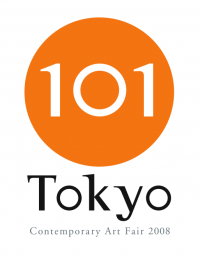 Today, 101Tokyo Contemporary Art Fair announced that it plans to expand for its next installment, upping the number of participating galleries to 60, from this year’s 28. Hence, it is calling for new, qualified directors to get in touch.
Today, 101Tokyo Contemporary Art Fair announced that it plans to expand for its next installment, upping the number of participating galleries to 60, from this year’s 28. Hence, it is calling for new, qualified directors to get in touch.
Having made sales of US $1 million, compared to the three-year-old Art Fair Tokyo’s US $10 million shows how much potential there is for the contemporary art market in Tokyo to take off if given the right platform.
Art Fair Tokyo currently occupies 3,000 square meters of the Tokyo International Forum each year, and is due to expand to 5,000 square meters in 2010. For next year, its Executive Director Misa Shin is looking at the possibility of holding a contemporary art annex to cater for the young commercial galleries that haven’t been able to make it into AFT so far.
We may never know whether AFT had this plan in mind before 101Tokyo appeared on the scene, or whether it’s a deliberate strategy to undercut 101Tokyo’s market before it takes root. Either way, a bit of competition in Tokyo’s art market can only be a good thing and I am looking forward to the coming months to see what kind of Tokyo Art Week takes shape for April 2009.
About & Community
A place to keep abreast of Art Space Tokyo related news, reviews, events and updates.
Art Space Tokyo is a 272 page guide to the Tokyo art world produced and published by Craig Mod & PRE/POST.
It was originally published in 2008 by Chin Music Press.
Current Tokyo exhibitions
Powered by Tokyo Art Beat
